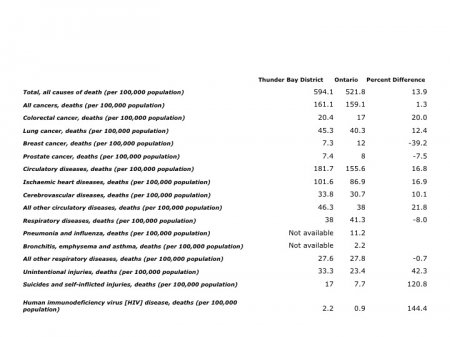 THUNDER BAY – Special to NNL – Statistics Canada provides a lot of valuable data and it is interesting from time to time to gather some data and make some comparisons between where we live here in Northern Ontario and the province as a whole. I collected the data on the age-standardized death rates for the Thunder Bay District Health Unit region and for Ontario from the community Health Profiles site and the results show that generally speaking, death rates in the region are higher than Ontario for most diseases.
THUNDER BAY – Special to NNL – Statistics Canada provides a lot of valuable data and it is interesting from time to time to gather some data and make some comparisons between where we live here in Northern Ontario and the province as a whole. I collected the data on the age-standardized death rates for the Thunder Bay District Health Unit region and for Ontario from the community Health Profiles site and the results show that generally speaking, death rates in the region are higher than Ontario for most diseases.
In terms of overall age-standardized deaths per 100,000 population (see table below), the number for the Thunder Bay District is 594.1 deaths while for Ontario it is 521.8 – about 14 percent higher. Once you start looking at the specific causes of death, large differences are present. For example, the colorectal cancer death rate is 20 percent higher, lung cancer death is 12.3 percent higher while death rates from heart disease, stroke and other circulatory conditions is 10.1 to 21.8 percent higher. Some exceptions are in the area of breast and prostate cancer death rates which are 39.2 and 7.5 percent lower in the Thunder Bay District compared to Ontario as a whole. Most disturbing is the accidental death rate – which is 42.3 percent higher in the District as well as the suicide rate which is 120.8 percent higher than Ontario’s and the HIV death rate which is 144.4 percent higher.
Some of these differences can no doubt be attributed to lifestyle factors. For example, residents in the Thunder Bay District Health Unit Region relative to Ontario as a whole are more likely to be overweight, obese, smoke and drink heavily as well as consume fewer fruits and vegetables. Some of it could also be due to lower educational attainment in the region given the well known correlation between education, income and health status. Some of it could also be due to medical access. For example, 84.4 percent of residents in the Thunder Bay District Health Unit Region report a regular medical doctor whereas 91.1 percent of Ontarians do. However, there are actually more family physicians per capita in the Thunder Bay District relative to Ontario but there are also far fewer specialists. As well, for many procedures, rates are actually higher in the Thunder Bay District (eg. knee replacements, hip replacements) which can either indicate better access or more chronic problems. For example, arthritis rates are also higher in the region compared to Ontario.
In any event, the reasons for the higher death rates in the region are complex. Nevertheless, death rates are higher and one needs to ask if all factors for this difference have been accounted for and if everything possible is being done to address this situation? Is a higher death rate simply an attribute of living in the North along with climate and the wildlife? Is it a function of the resources being spent on our regional health care system, in particular the shortage of specialists? Is it a lifestyle choice given the tendency towards more smoking, drinking and overeating in the region? Is there something we can learn in how breast and prostate cancer is being handled in the region given the lower death rates there that can be applied to other conditions? How to reduce the death rate to reflect the rest of the province? Interesting questions for which I do not have answers.
Livio Di Matteo
 Livio Di Matteo is an economist in Thunder Bay, Ontario specializing in public policy, health economics, public finance and economic history. Livio Di Matteo is a graduate of the Fort William Collegiate Institute (1898-2005) whose school motto “Agimus Meliora” has served as a personal inspiration. Livio Di Matteo holds a PhD from McMaster University, an MA from the University of Western Ontario and an Honours BA from Lakehead University. He is Professor of Economics at Lakehead University where he has served since 1990. His research has explored the sustainability of provincial government health spending, historical wealth and asset holding and economic performance and institutions in Northwestern Ontario and the central North American economic region. His historical wealth research using census-linked probate records is funded by grants from the Social Sciences and Humanities Research Council of Canada. He has constructed, assembled and analyzed nearly 12,000 estate files for Ontario over the period 1870 to 1930. Livio Di Matteo writes and comments on public policy and his articles have appeared in the National Post, Toronto Star, the Winnipeg Free Press and Thunder Bay Chronicle-Journal and NetNewsledger.com. Livio Di Matteo has had an entry in Canadian Who’s Who since 1995.
Livio Di Matteo is an economist in Thunder Bay, Ontario specializing in public policy, health economics, public finance and economic history. Livio Di Matteo is a graduate of the Fort William Collegiate Institute (1898-2005) whose school motto “Agimus Meliora” has served as a personal inspiration. Livio Di Matteo holds a PhD from McMaster University, an MA from the University of Western Ontario and an Honours BA from Lakehead University. He is Professor of Economics at Lakehead University where he has served since 1990. His research has explored the sustainability of provincial government health spending, historical wealth and asset holding and economic performance and institutions in Northwestern Ontario and the central North American economic region. His historical wealth research using census-linked probate records is funded by grants from the Social Sciences and Humanities Research Council of Canada. He has constructed, assembled and analyzed nearly 12,000 estate files for Ontario over the period 1870 to 1930. Livio Di Matteo writes and comments on public policy and his articles have appeared in the National Post, Toronto Star, the Winnipeg Free Press and Thunder Bay Chronicle-Journal and NetNewsledger.com. Livio Di Matteo has had an entry in Canadian Who’s Who since 1995.
This article was originally posted on Livio Di Matteo’s NORTHERN ECONOMIST Blog at http://ldimatte.shawwebspace.ca.



